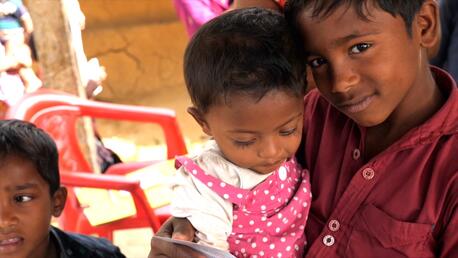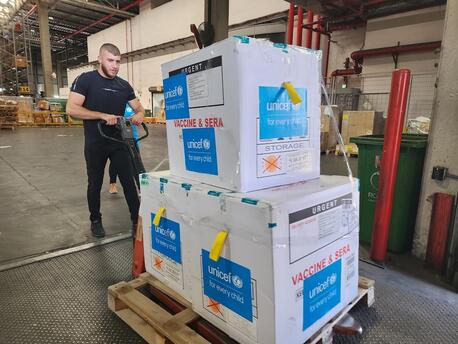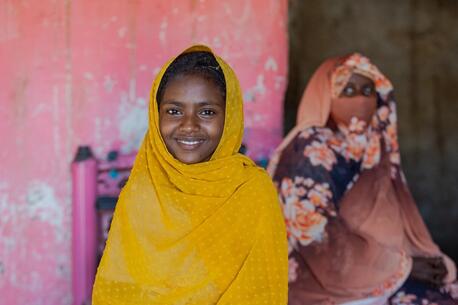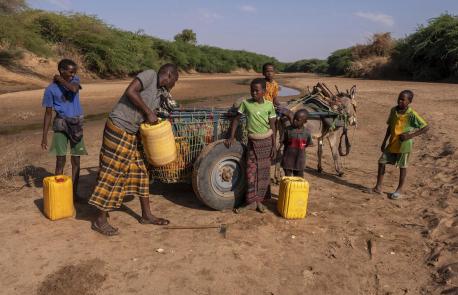
Where Water Is Scarce, UNICEF Offers a Fresh Take on Drilling
UNICEF and partners are using remote sensing to locate and extract groundwater in drought-prone regions of Ethiopia and Madagascar — and looking to expand the project to help more communities address water scarcity, one of the most dangerous effects of climate change and one that disproportionately impacts already vulnerable children.
Each morning, 13-year-old Aysha wakes up before sunrise to fetch water for her family in Ethiopia, where she lives. For Aysha — one of an estimated 2.1 billion people in the world who lack sufficient, reliable access to water — it is an eight-hour trek round trip.
Like other countries in East and Southern Africa, Ethiopia is prone to drought and water shortages. Water scarcity has increased in these and other regions of the world as a result of climate change, with far-reaching consequences for vulnerable children and families.
When water is scarce, girls are often the ones sent to fetch it
In impacted communities, it is common for the burden of retrieving water to fall on women and girls like Aysha. Children who take on the chore often miss out on education as a result. Families, in an effort to stay alive, often become displaced.

In many cases families have to rely on temporary solutions, like drawing water from storage tanks that stock rainwater. In times of emergency, water trucking is the only alternative.
The challenges of drilling for water in Africa
In places that get little rainfall, groundwater is the most viable water source. The challenge is drilling for it. In East and Southern Africa, complex geographical terrain makes it difficult to accurately estimate where groundwater is hiding. Drilling success rates are low as a result — typically under 50 percent.
With more than half of all wells that are drilled coming up dry, it is clear that drilling for water using traditional methods wasn't going to solve the water crisis in water-insecure communities. Without accurate and effective underground drilling — and a better understanding of how groundwater is refilled, or “recharged" from rainwater — drought remains a critical threat to millions of children.
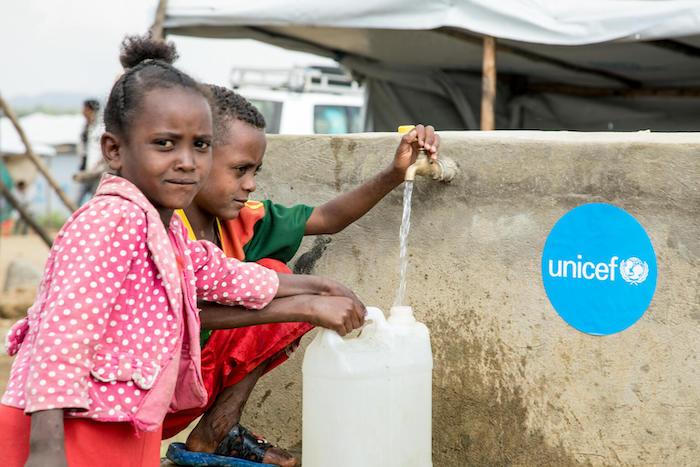
UNICEF's More Water More Life initiative attempts to tackle these issues by introducing a way of mapping deep aquifers — bodies of permeable rock that contain groundwater — using satellites and science. The initiative's innovative approach is to use remote sensing, informed by data from satellite imagery, to scan the Earth for sites with the highest potential for successful extraction by borehole.
UNICEF's groundwater mapping project directly improved access to safe water for 740,000 children in Ethiopia
The project team tested the approach first in northern Ethiopia, in the Elidar district of the Afar region, with great results. By adding the extra step of remote sensing, and mapping out extraction sites in advance, they were able to cover wider areas — including remote areas and others deemed fragile due to conflict (that has only intensified in and around Tigray) — to find the best sources. Remote sensing also helped identify and avoid groundwater sources prone to saline and fluoride contamination.
Groundwater drilling accuracy and efficiency improved, as did Ethiopia's overall drilling success rates, which jumped from 50 percent to 92 percent in the first year — improving water access for 1.2 million people, including 740,000 children.
Similar efforts in Madagascar, where UNICEF teamed up with the European Union/Joint Research Center to launch the project in 2017, are showing promise as well.
Finding groundwater in drought-prone Madagascar
In addition to chronic drought, Madagascar has its own specific challenges to extracting groundwater, in part because major groundwater basins are located close to the coasts and therefore subject to salt water intrusion.
Applying the more advanced mapping technology from More Water More Life, the project team created an enhanced groundwater suitability map, using it to identify the best sites for 25 new boreholes in the southern regions of Androy and Atsimo Andrefana. Hand pumps were installed at each borehole to provide clean and safe water to about 7,000 people in rural communities.

There are two other advantages to the More Water More Life way of groundwater extraction. The delivery of clean water is cost effective, at around 50 cents per person; and because the process does not deplete the aquifer, it is considered environmentally sustainable.
Expanding groundwater mapping has the potential to benefit some 40 million children in East and Southern Africa alone
UNICEF is now looking to expand groundwater mapping in Ethiopia and Madagascar as well as Angola, Kenya and Somalia, where the needs for improved water supply and access remain acute.
“We have over 40 million children living in extreme water vulnerability who could benefit," says Kitka Goyol, WASH (Water, Sanitation and Hygiene) Chief for UNICEF Ethiopia.
When there is reliable access to safe water, children are able to attend school and focus on learning. They are more likely to maintain good health and hygiene, less likely to get sick or experience food insecurity. They are more likely to not only survive, but thrive. The local economy gets a boost as well. Farmers can more easily tend to crops and care for livestock.
As long as access to safe water remains a challenge, mothers like Fatuma will continue to struggle.
“This year the lean season is particularly long, so I am very worried," Fatuma told UNICEF in an interview earlier this month. "The next rains are not expected to arrive before August. People are hungry and thirsty.”
The More Water More Life initiative is one of many projects in UNICEF's innovation portfolio focused on helping communities mitigate and adapt to climate change impacts. UNICEF strives to align technical and financial resources behind promising projects that can accelerate results for children. Learn more about how UNICEF is advancing innovative solutions and technologies to address some of the biggest global challenges.
UNICEF works in 190 countries and territories to meet urgent needs of vulnerable children and to protect their rights. Help UNICEF increase its impact. Donate today.
HOW TO HELP
There are many ways to make a difference
War, famine, poverty, natural disasters — threats to the world's children keep coming. But UNICEF won't stop working to keep children healthy and safe.
UNICEF works in over 190 countries and territories — more places than any other children's organization. UNICEF has the world's largest humanitarian warehouse and, when disaster strikes, can get supplies almost anywhere within 72 hours. Constantly innovating, always advocating for a better world for children, UNICEF works to ensure that every child can grow up healthy, educated, protected and respected.
Would you like to help give all children the opportunity to reach their full potential? There are many ways to get involved.



